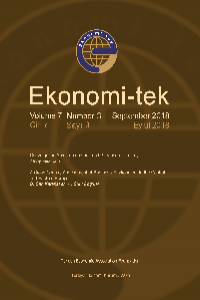Sanayisizleşmeyi Yeniden Düşünmek: Alternatif Bir Gösterge Olarak Kişi Başına İmalat Katma Değeri
Sanayisizleşmeyi ölçmek için genellikle GSYH içinde imalat sanayinin payı kullanılır. Çalışma, kişi başına imalat sanayi katma değerini alternatif bir gösterge olarak önermektedir. Bu iki gösterge, farklı coğrafyalardan ve farklı sanayileşme düzeylerinden seçilen örnek ülkelerde sanayisizleşmeyi incelemek için kullanıldı. Sonuçlar, sanayileşmenin varlığına ilişkin değerlendirmelerin kullanılan göstergeye göre farklılaşabileceğini göstermektedir. İmalat sektörünün payı azalsa bile kişi başına katma değer artabilir ve bu da sanayisizleşme olduğuna dair yanıltıcı bir değerlendirmeye yol açabilir.
Anahtar Kelimeler:
Sanayisizleşme, erken sanayisizleşme, yapısal dönüşüm, küreselleşme
Rethinking Deindustrialization: Per Capita Manufacturing Value Added as an Alternative Indicator
Share of manufacturing in GDP is widely used as the main indicator to measure the degree of deindustrialization. The paper proposes per capita manufacturing value added as an alternative indicator. These two indicators are employed to scrutinize the deindustrialization in the selected sample countries from different regions and different industrialization levels. Results show that assessments regarding the existence of industrialization may differ depending on the indicator used. Even if the share of the manufacturing sector decreases, the value added per capita may increase, which may lead to a misleading assessment that there is a deindustrialization.
___
- Baldwin, R. ve J. Lopez‐Gonzalez (2015), “Supply‐chain Trade: A Portrait of Global Patterns and Several Testable Hypotheses,” The World Economy, 38 (11): 1682-1721.
- Baldwin, R. (2016), The Great Convergence: Information Technology and The New Globalization, Cambridge, Massachusetts: The Belknap Press of Harvard University Press.
- Clark, C. (1940), The Conditions of Economic Progress, London: Mac Millan.
- Cornwall, J. (1980), “Modern Capitalism and the Trend toward Deindustrialization,” Journal of Economic Issues, 14(2): 275-289.
- Dasgupta, S. ve A. Singh, (2006), “Manufacturing, Services and Premature Deindustrialization in Developing Countries: A Kaldorian Analysis,” WIDER Working Paper Series RP2006-49, World Institute for Development Economic Research (UNU-WIDER).
- Doğruel, A. S. ve F. Doğruel (2017), “Türkiye’de Sanayileşme ve Kriz,” M Koyuncu, H Mıhçı ve E. Yeldan, der. içinde, Geçmişten Geleceğe Türkiye Ekonomisi - Fikret Şenses’e Armağan, İstanbul, İletişim Yayınları: 45-73.
- Doğruel, F. ve A. S. Doğruel (2018), Bıçak Sırtında Büyüme ve İstikrar: Küreselleşmenin Yükselişi ve Düşüşü, Genişletilmiş 2. Baskı, İstanbul, İstanbul Bilgi Üniversitesi Yayınları.
- Dünya Bankası WDI, World development indicators. Washington, D.C.: The World Bank.
- Kaldor, N. (1966), Causes of the Slow Rate of Economic Growth of the United Kingdom, An Inaugural Lecture. London, Cambridge University Press.
- Kuznets, S. (1966), Modern Economic Growth: Rate, Structure and Spread, New Haven and London, Yale University Press.
- Rodrik, D. (2016), “Premature deindustrialization,” Journal of Economic Growth, 21(1):1-33.
- Rosenstein-Rodan, P. N. (1943), “Problems of Industrialization of Eastern and South-Eastern Europe,” The Economic Journal, 53(210/211): 202-211.
- Rowthorn, R. ve R. Ramaswamy (1997), “Deindustrialization–Its Causes and Implications,” Economic Issues No:10, International Monetary Fund, September.
- Szirmai, A., ve B. Verspagen (2015), “Manufacturing and Economic Growth in Developing Countries, 1950–2005,” Structural Change and Economic Dynamics, 34(September): 46–59.
- Timmer, M., G. de Vries ve K. de Vries (2016), “Patterns of Structural Change in Developing Countries,” J. Weiss, ve M. Tribe, der. içinde, Routledge Handbook of Industry and Development, Routledge Handbooks, Routledge: 65-83.
- ISSN: 2146-6173
- Yayın Aralığı: Yılda 3 Sayı
- Başlangıç: 2012
- Yayıncı: Türkiye Ekonomi Kurumu Vakfı
